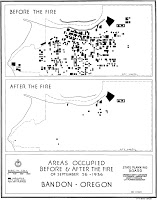Timeline of Disaster Relief (1936)
When one hears about all of the activities the Red Cross is in the process of undertaking internationally, one can’t help but question what would happen if disaster struck here. A recently found document from 1936 allows us a peak as to what happens during a disaster, from the command centers’ perspective. A log from the command center of Oregon Governor Charles H. Martin 74 years ago this week when the Oregon South Coast was threatened by fire, a fire that destroyed the community of Bandon.
 “This document gives a complete new insight into the destruction of Bandon in 1936,” notes Judy Know, the executive director of the Bandon Historical Society Museum. “It tells a lot about how the fire was perceived and fought, and how a variety of people and agencies — from an empathetic resident of Salem to the massive federal government — responded to the catastrophic events here. It’s an inside view and a completely different perspective that none of the fire’s survivors or Historical Society members had ever had our hands on before.”
“This document gives a complete new insight into the destruction of Bandon in 1936,” notes Judy Know, the executive director of the Bandon Historical Society Museum. “It tells a lot about how the fire was perceived and fought, and how a variety of people and agencies — from an empathetic resident of Salem to the massive federal government — responded to the catastrophic events here. It’s an inside view and a completely different perspective that none of the fire’s survivors or Historical Society members had ever had our hands on before.”
Here are some excerpts from the document, with more available at The Bandon Western World–
Sept. 27, 1936
8 a.m.: Governor learns of fire situation and orders Red Cross, Oregon State Police and Oregon Army National Guard contacted to begin mobilizing aid.
8:15 a.m.: San Francisco Red Cross is sending food, medical, shelter and other aid while calling on national Red Cross organization for additional help. Twenty state police officers are dispatched to the area from Eugene, Roseburg and Salem. National Guard Brig.-Gen. Thomas E. Rilea puts the Guard unit at Marshfield (Coos Bay) on alert. U.S. Naval Reserve Ensign James P. Biland starts amateur radio operator chain between Marshfield and Salem in case fire takes out phone lines in the Coquille area, where fire is reported to be endangering the city.
10 a.m.: National Guard units at Clackamas, Eugene, Roseburg and Grants Pass put on alert. U.S. Coast Guard Cutter Pulaski from Marshfield is anchored off Bandon and waiting for flood tide; Cutter Onondago from Astoria to arrive at Bandon around 8 p.m.
12:40 p.m.: Governor contacts Ninth U.S. Army Corps commander Maj.-Gen. George S. Simonds to request loan of cots, blankets, cook stoves and utensils; also may need troops to fight fire; Simonds to forward request to Washington, D.C. Three Work Projects Administration trucks were dispatched to the coast carrying federal commodities including 175 cases of beer, 68 sacks of flour, 450 blankets, 25 cots and an unspecified amount of canned fruits and vegetables.
6:24 p.m.: Portland police chief offers aid of its Sunshine Division.
8:50 p.m.: Highway Commission concentrating on keeping communications open and enabling free movement of firefighters and evacuees, if necessary. Twenty commission trucks and 150 men sent to the area from Eugene and Grants Pass-Medford. Two men with firefighting equipment assigned to each wooden bridge.
11:15 p.m.: Marion County Red Cross calls to offer aid; has a good supply of clothing.
Sept. 28, 19364:10 p.m.: Telegram received from President Franklin D. Roosevelt — I am much distressed at reports reaching us of the disastrous coast fires. Stop. Please keep me fully advised. Stop. I am instructing all federal agencies to render whatever assistance possible.
4:40 p.m.: Gov. Martin’s reply — Fire situation greatly improved due to higher humidity and low velocity of winds. Stop. No other cities in immediate danger unless weather conditions change for the worse. Stop.
Photo 1: Oregon State Archives– Occupied Areas Before/After Fire
Photo 2: Oregon Historical Society
Photo 3: KDRV (Medford)